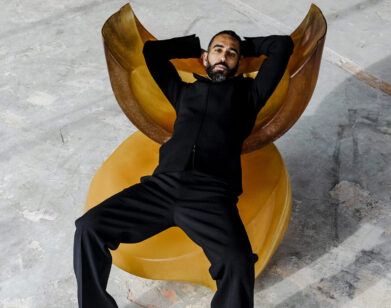Victoria Sambunaris’s Western Shots

Untitled, 2008.
Armed with a 5×7 large-format camera, a copy of John McPhee’s Annals of the Former World, and a proper sense of awe, photographer Victoria Sambunaris headed West from New York last September. A longtime documenter of the American West and its incumbent landscape, both natural and manmade, Sambunaris met up with the Wyoming geologist Charlie Love, whose father was the renowned geologist David Love, and whose great-uncle was the environmentalist John Muir—a deep-set genealogical history traced by McPhee in Annals.
“I had not planned to stay …” wrote the great nature essayist Gretel Ehrlich about Wyoming. Something about the landscape of that wide-open state, and the knowledgeable guidance of her travel companion David Love—they went on a four-day journey to visit Wyoming’s most prized natural beauties, including Yellowstone National Park—caused Sambunaris to return a month later, on her own.
This trip is the one seen in Terra Firma, a show of Sambunaris’ landscape photographs from the past year opening tonight in the fourth-floor Gallery at Hermès, on Madison Avenue. Terra Firma is curated by Cory Jacobs, a 34-year-old photography editor and curator, with the Foundation d’entreprise Hermès, a philanthropic organization founded last April.
“Victoria’s process embodies many of the core values of Hermès,” says Jacobs. “She is rigorous, uncompromising, and, one could say, obsessed with her craft.” That obsession with the vast horizons of the West and the interventions of both man and nature on that openness has evolved into a career-long undertaking. “Her new work is a continuation of themes that have run through the last decade of her imagery,” says Jacobs. “Now she’s focused on the volatile area surrounding the Yellowstone hotspot and Idaho’s Snake River Plain.”
Not many people realize that below Yellowstone lies the largest active North American volcanic system. The Yellowstone caldera, a 34 mile-by-45 mile supervolcano, erupts approximately approximately every 640,000 years—or, right about now. It is a phenomenal thing to comprehend, and Sambunaris’s images have that sense of wonder about them. They evoke not only the 19th century landscape photographers she cites as direct influences—Carleton Watkins and William Henry Jackson—but also early Hudson River School painters of the American West like Albert Bierstadt.
Of course, there is now the issue of modernization; whereas, in Bierdstadt’s day, there were less manmade intrusions on the view. But Sambunaris takes special care not to condemn what we have wrought; machines and technology are just as much a part of the landscape as the rocky striatum. “There has been quite a lot of intervention along the way,” says Jacobs. “And Victoria documents it, just not in a heavy-handed way. There is no doubt her photographs are beautiful, but of course there is much more at work in these pictures.”
Victoria Sambunaris: Terra Firma runs from September 8 to October 9, 2009, at the Gallery at Hermès, 691 Madison Ave, New York.






